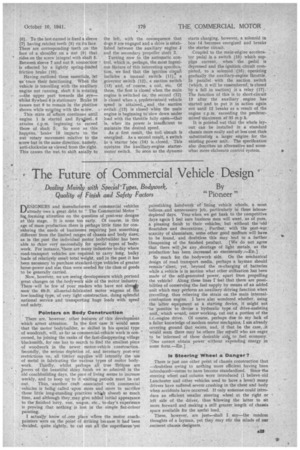The Future of Commercial Vehicle : Design Dealing Mainly with Special Types, Bodywork, By .
Page 25

If you've noticed an error in this article please click here to report it so we can fix it.
Quality of Finish and Safety Factors "Pioneer "
ESIGNERS and manufacturers of commercial vehicles L./already owe a great debt to "The Commercial Motor " foie focusing attention on the question of post-war designs at this stage. It is none too early. Of course, in this age of mass production there is perhaps little time for considering the needs of businesses r-nuiring just something . different from the limited ranges of chassis and body sizes; as in the past the individual motor bodybuilder has been able .to ceiter very successfully for special types of bodywork. For instance, here are many industries to-day where road-transport vehicles are required. to carry long, bulky ,
' loads of relatively small total weight, and in the past it has been necessary to purchase standard-type vehicles of greater horse-power and size than were needed for the class of goods to be generally carried.
Now, however, we are Seeing developments which portend great changes on the bodywork side of the motor industry. Therewill be few of your readers who have not alreari seen the 60-ft. all-metal-fabricated motor wagons of flie low-loading type, of very light construction, doing splendid national service and transporting huge loads with speed and safety.
Pointers on Body Construction
There are, however, other features of this development which arrest attention. In the first case it would seem that the motor bodybuilder, so skilled in his special type of woodcraft, will, as far as commercial-vehicle work is concerned, be joining the ranks of the fast-disappearing village blacksmith, for one has to search to find the smallest piece of woodwork in the newer motor-vehicle construction. Secondly, the serious depletion of, and necessary post-war restrictions on, all timber supplies will intensify the use of metal in fabricating the various types of motor bodywork. Thirdly, whilst perhaps all true Britons are
, lovers of the beautiful shiny finish we so adnairea in the old coachbuilding days, the pace of living seems to increase weekly, and to keep up to it waiting periods must be cut
out. Thus, another craft associated with commercial vehicles is beihg. called 'upon more and more to sacrifice those little long-standing -practices whi‘h absorb so much time, and although they may give added initial appearance to the _finished lorry, van, wagon, etc., to-day's experience is proving that nothing is lost in the simple flat-colour painting.
I actually know of one place where the motor coachpainters were on the point of Striking because it had been decided, quite rightly, to cut out all the superfluous 'yet
painstaking handwork of lining vehicle wheels, a most tedious.and unnecessary job, particularly in these labourdepleted days. Yesp when we get bask to the competitive days again I feel sure business men will want, as of yore, a pleasing finish to their vehicles, but without the 'old flourishes and decorations. Further,' with the post-war' scarcity of aluminium, some other good medium will have to be found, and . doubtless this may lead to a further Cheapening of the finished product. [We do not agree that there wi1l4be any ,shortage of light metals, as the productionhas been increased so enormously.—En.] So much for the bodywork side. On the mechanical design of road transport media, perhaps a layman should remain'silent, yet, beyond the re-charging of batteries while a vehicle is in motion what other utilization has been made of the self-generated power, apart from propelling the vehicle? Along these lines r feel that there are possibilities of conserving the fuel supply by means of an added unit which may perform an auxiliary driving function when travelling, thus relieving the strain on the main internalcombustion engine. I have also wondered whether, using the latter equipment as a starting device, it might not 'be possible to devise a hydraulic type of drive-assisting unit,, which would, once working, cut out a portion of the i.c.-engine drive. Of course, perhaps due to my lack of a fuller knowledge of modern motor mechanics, I am already covering ground that exists, and, if that be the case, it would seem there may be others like !myself who are eager to be informed of these desirable aids to fuel economy. [One cannot obtain power without expending energy in some form.—En.] .
Is Steering Wheel a Danger?
There is just one other point of chassis construction that —doubtless owing to nothing more efficient having been introduced—seems to have become standardized, Since the steering wheel and column were introduced (I believe old Lanchester and other vehicles used to have a lever) many drivers have suffered severe crushing in the chest and body when accidents have occurred. If only someone could introduce an efficient smaller steering wheel at the right or left side of the driver, thus llowing the latter to sit more forward and making a still greater length of chassis space available for the useful load.
These, however, are just,--shall I say—the random thoughts of a layman: yet they may stir the minds of our eminent chassis designers.




















































